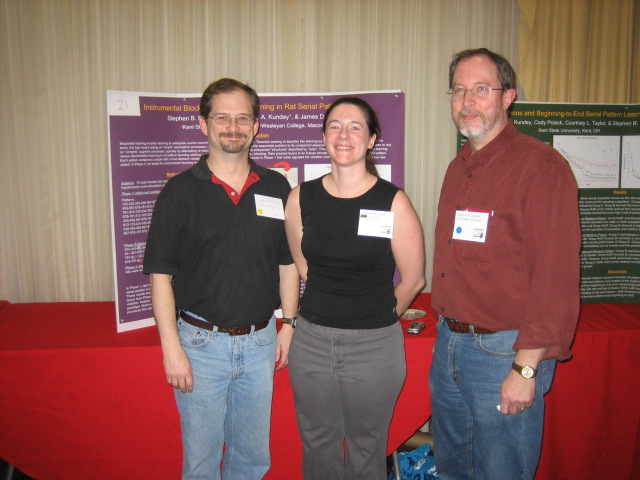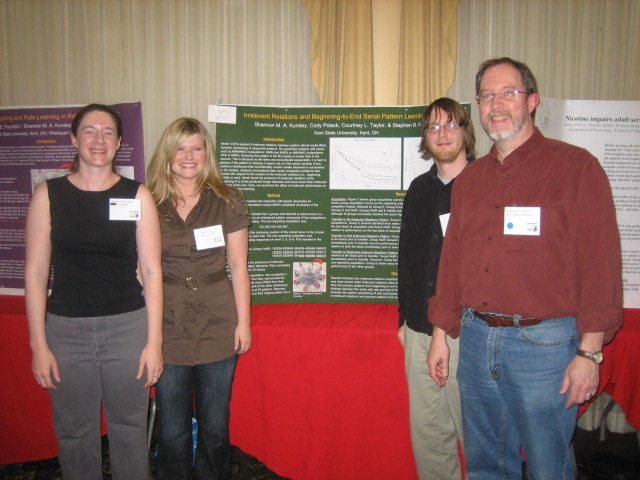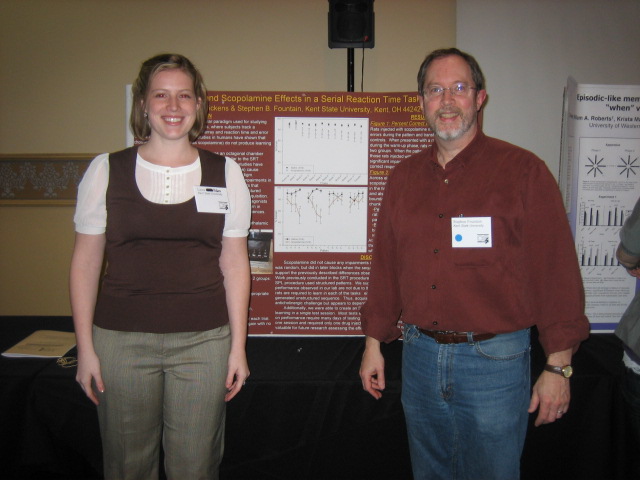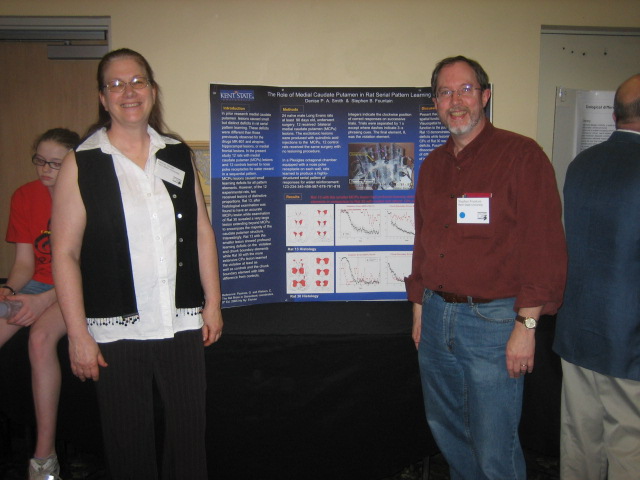|
Poster Abstracts:

Instrumental Blocking and Rule Learning in Rat
Serial Pattern Learning.
PDF
Stephen B. Fountain, Shannon M. A. Kundey (Kent
State University), & James D. Rowan (Wesleyan College)
In a study of instrumental blocking in serial
pattern learning, rats learned to press levers in a circular array
according to a rule-based serial pattern,
123-234-345-456-567-678-781-812, where digits indicated the clockwise
position of the correct lever in the array for each trial. Each pattern
presentation contained a chunk with a final element violation, such as
232 instead of 234. Rats first learned that a noise signaled the
violation chunk; then, a concurrent spatial cue was added. A test with
spatial cues alone showed that blocking occurred, but rats also made
rule-consistent errors on the violation trial. The results indicated
associative learning mediated cuing of violation elements and concurrent
rule learning of pattern structure. The results thus implicate multiple
concurrent learning processes in rat serial pattern learning.

Irrelevant Relations and
Beginning-to-End Serial Pattern Learning in Rats.
PDF
Shannon M. A. Kundey, Cody
Polack, Courtney L. Taylor, & Stephen B. Fountain (Kent State
University)
Hersh (1974)
reported that irrelevant relations at the beginning of serial patterns
impaired humans’ performance on letter series completion problems more
than when they were at the end. We examined the effect of irrelevant
relationships on rat serial pattern learning. Rats learned to press
levers in a circular array according to the same structured serial
pattern interleaved with repeating responses on lever 2, 6, or 8:
122232-223242-324252-425262-526272 (Beginning),
162636-263646-364656-465666-566676 (End), or
182838-283848-384858-485868-586878 (No Irrelevant Relations), where
digits indicated the clockwise position of the correct lever in the
array for each trial. Irrelevant relationships retarded learning more
when at the beginning versus the end of the pattern. Thus rats, like
humans, process serial patterns from beginning to end.

Pattern Structure and
Scopolamine Effects in a Serial Reaction Time Task for Rats.
PDF
Laura R. G. Pickens & Stephen B.
Fountain (Kent State University)
Muscarinic
anticholinergic drugs cause profound impairments in rat serial pattern
learning but not in acquisition of serial reaction time (SRT) tasks in
humans and rats.
We examined the effects of scopolamine (0.6 mg/kg i.p.) on acquisition
of a
patterned SRT task in which rats tracked flashing lights in a horizontal
8-light array by pressing levers below the lights. On the
drug-injection day, rats received a novel patterned sequence,
2345-4567-7654-5432, where digits represent the array position of the
correct lever for each trial. Scopolamine rats made more errors than
controls in the first half of the pattern on elements within chunks and
in the second half of the pattern at chunk boundaries. Thus,
acquisition in SRT tasks is not inherently resistant to anticholinergic
challenge; drug effects depend on the nature of the sequential
information to be learned.

The Role of Medial Caudate Putamen in Rat Serial
Pattern Learning. PDF
Denise P. A. Smith and Stephen B. Fountain (Kent
State University)
The present experiment examined whether medial
caudate putamen lesions would cause deficits in rat serial pattern
learning. Rats learned to nose poke receptacles arranged in a circular
array according to a serial pattern of eight 3-element chunks,
123-234-345-456-567-678-781-818, where digits indicated the clockwise
position of the correct receptacle for each trial. The final element of
the sequence violated pattern structure. Medial caudate putamen lesions
caused small learning deficits for all pattern elements except the
violation element. One rat with a distinctive lesion had profoundly
impaired acquisition for Element 1 of chunks and the violation element.
These results indicate that medial caudate putamen lesions produce a
different pattern of impairments than we have previously observed for
the drugs MK-801 and atropine, hippocampal lesions, or medial frontal
lesions.
|